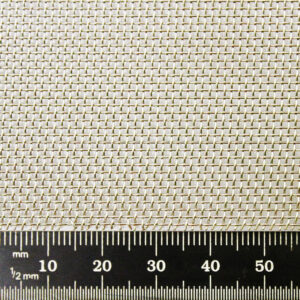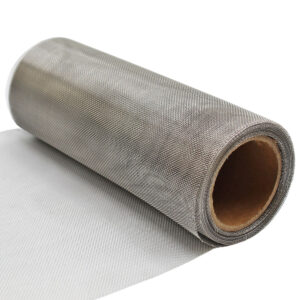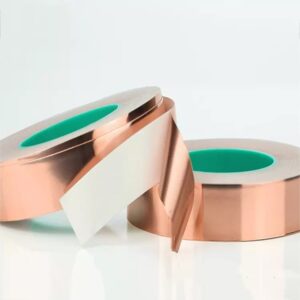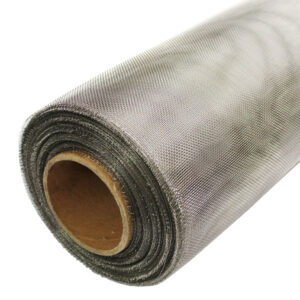







£16.99 inc VAT


This website is secured:
✔ The UK’s Largest Range Of Mesh Products
✔ FREE UK Delivery Included
✔ Immediate Express Dispatch From Stock
✔ Tracked Delivery with Order Updates
✔ 30-Day Returns Accepted
£ Check Out Our Clearance Listing For Savings
@ ☏ Bespoke Sizes & Larger Sheets Available
Crafted from high-quality stainless steel wire, this insect mesh netting provides a robust barrier against pests for homes, buildings, and other structures. Its finely-woven design ensures even the tiniest insects are kept out, while the corrosion-resistant material makes it apt for outdoor use. Designed for both strength and adaptability, it’s simple to install and customisable to various sizes or shapes.
The mesh boasts specifications like 16 holes per linear inch and a wire thickness of 0.23mm. This netting can be conveniently trimmed using standard kitchen scissors.
Stainless steel insect mesh netting is a type of mesh made from high-quality stainless steel wire that is used to keep insects and other pests out of homes, buildings, and other structures. The mesh is woven in a specific pattern to create a netting that is strong and durable, yet fine enough to prevent even small insects from passing through. The stainless steel material is resistant to corrosion, making it ideal for use in outdoor applications where it may be exposed to harsh weather conditions. In addition to its strength and durability, stainless steel insect mesh netting is also easy to install and can be cut to fit any size or shape. Whether you need to protect your home or business from unwanted pests, stainless steel insect mesh netting is a reliable and effective solution to consider.
We also offer a midge mesh if you require an insect mesh with an even smaller hole.
The specifications of this stainless steel fly mesh are as below:
Our group have been in the mesh industry for over 150 years. We are one of the UK’s most trusted mesh suppliers because:
The Mesh Company has an enormous range of insect mesh products. We truly are an industry leader among suppliers of weld mesh and woven wire materials. With the capabilities we have in-house, we can provide virtually anything you require.
Fibreglass, aluminium materials are also available in large stock quantities at bargain prices. See our blogs for specific information on all of our various.
Woven stainless steel insect mesh is typically made by weaving stainless steel wires together to create a mesh fabric that is fine enough to prevent insects and other small pests from entering a building or space.
The process of creating woven stainless steel insect mesh typically involves the following steps:
To get A4 sheets from the insect mesh, here at The Mesh Company we cut down large rolls of this mesh with our ultra-powerful slitting machine. We are then able to cut A4 sheets from the smaller rolls using scissors or tinsnips.
The ability of flies to get through mesh depends on the size of the mesh openings and the size of the flies. In general, woven stainless steel insect mesh with a mesh opening of 1.2 mm or smaller is considered to be effective in preventing the entry of most common household flies, including house flies and fruit flies. This mesh has a 1mm hole, so it is ideal.
However, it’s important to note that some smaller species of flies, such as fungus gnats, may be able to pass through even the smallest mesh openings. Additionally, some larger flies, such as horse flies, may be able to force their way through a mesh that is not securely installed or has been damaged.
We offer a midge mesh which has a smaller hole and will stop bugs of this tiny size.
Stainless steel and aluminium are both popular materials for insect mesh, which is used to keep insects and debris out of buildings while still allowing air to flow through. Here are some key differences between the two materials:
Overall, The Mesh Company would recommend using stainless steel over aluminium as insect mesh. Despite stainless steel being more expensive, you may get more for your money as it’s more durable and long-lasting therefore saving money in the long run.
A4 sheets of insect mesh can be used for a variety of applications where a small amount of mesh is needed to keep insects and debris out while still allowing air to flow through. Here are a few examples:
Check out our blog everything that you need to know about stainless steel insect mesh for more information on this product. Our goal for our blogs and help guides is to answer as many questions as possible to help to explain the possibilities of mesh to our customers. Contact our team today if you have any questions at all. We are always really keen to help in any way that we can.
You may also be interested in our blog about soffit vent mesh. This is a common use for insect mesh of all types.
Fence posts and tools will need to be purchased separately.
We also offer similar products through our highly popular eBay store, check us out there too.
In 2008 Locker Wire Weavers launched The Mesh Company to bring our enormous range of wire mesh products to the general public for the first time. Previously wire mesh was only available for trade customers.
We continue to extend our range, and now proudly offer many forms of mesh and metal products for the best possible prices. We specialise in woven wire mesh. As a group we work closely with architects and designers to develop ground-breaking new applications for our multifunctional range of materials. We also offer state of the art fabrication and engineering for projects of all sizes.
Strong ties with the Warrington community continue to be at the very core of our business. We are proud to invest in the training and developing our staff of all levels in line with the traditions set by Thomas Locker, who founded our group 150 years ago when he invented the electronic loom. We continue to bring ingenuity and strong ethics to our day to day business.
The Mesh Company continues Warrington’s historic role in the wire industry. For more than 140 years, our group has been a leader in the supply and manufacture of woven wire mesh and wire cloth. Having been founded in Warrington, UK in 1878, Locker mesh products still retain the quality craftsmanship and spirit of innovation that were so characteristic then.
Available Options
You will find full rolls of this insect netting here. Please be advised that the majority of woven mesh is usually available in a maximum roll size of 30 metres by 1200mm. Please email us if you wish to discuss purchasing this mesh in any size – sales@themeshcompany.com.
Feel free to call us if you wish to discuss any of our products – (+ 44) 01925 406 602. We are always happy to help in any way that we are able to.
We also offer this product through our highly popular eBay store, check us out there too.




The largest range of wire mesh, chicken wire, wire fencing, woven wire mesh and perforated metal products in Europe, delivered direct from our Warrington warehouse.




Website by: Beech Web Services | Terms and Conditions | Cookie Policy | Privacy Policy | Website Terms and Conditions
Reviews
There are no reviews yet.